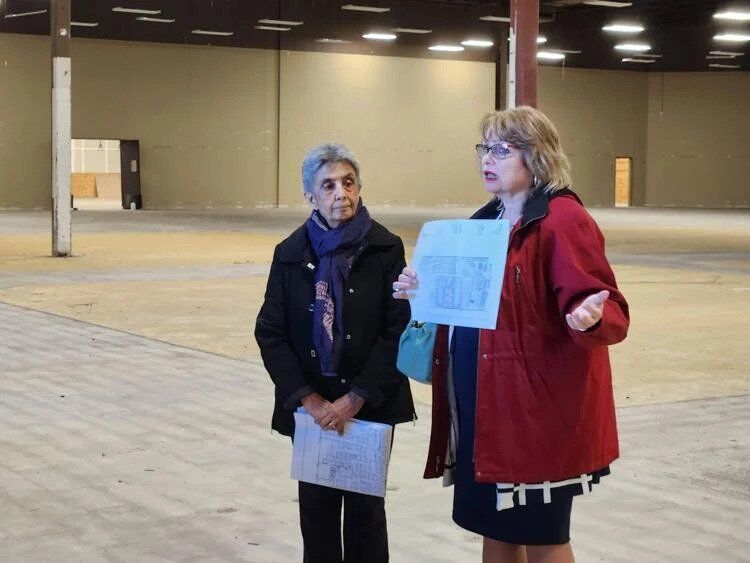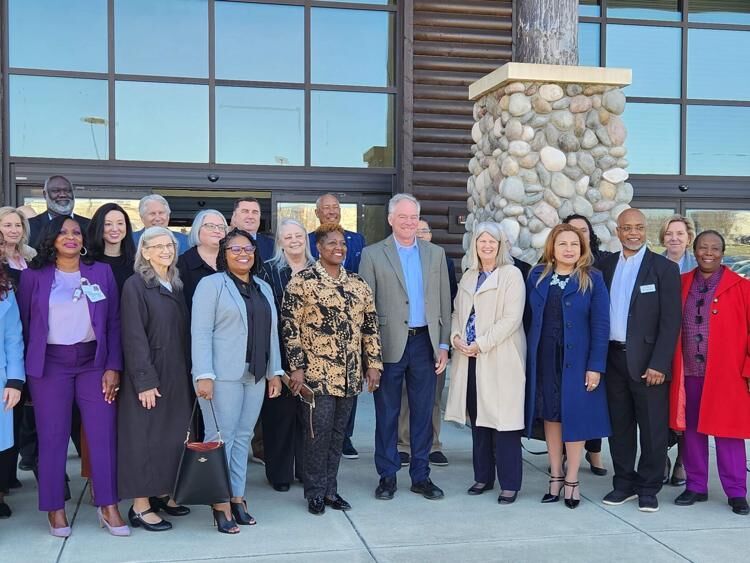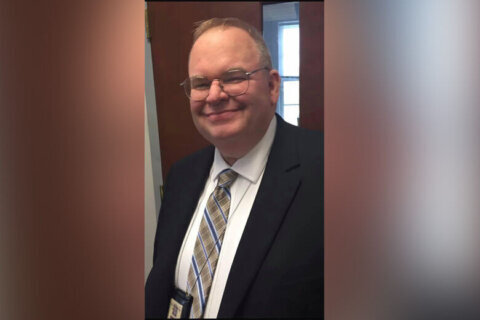This article was republished with permission from WTOP’s news partner InsideNoVa.com. Sign up for InsideNoVa.com’s free email subscription today.
This article was written by WTOP’s news partner InsideNoVa.com and republished with permission. Sign up for InsideNoVa.com’s free email subscription today.
The former Gander Mountain store in Woodbridge didn’t look like much Monday morning, its shop floor empty, concrete flooring exposed and paint peeling in places.
But in Prince William County Community Services Director Lisa Madron’s hands were plans of what the 79,000-square-feet space could soon be for those in desperate need of mental health services.
Madron was leading Sen. Tim Kaine, D-Va., and over a dozen other elected officials and local health care leaders on a tour Monday of what will soon be the county’s first crisis receiving center, a project that Kaine and his congressional colleagues helped fund through an appropriations request.
Scheduled to open in 2024, the center will have 16 units for 23-hour observation of adults and 16 in-patient beds for those who require monitoring beyond 23 hours, typically three to five days, according to Madon. As of right now, the plan is for eight youth observation units and eight youth beds, though leaders are hopeful that they can attain approval for a 16-by-16 youth setup as well.
The space is there for additional units, Madron said. And increasing the number of beds could actually be more cost-effective, as the additional beds would require minimal additional staffing but would increase reimbursement revenues. Most importantly, allowing for more youth beds and observation units would do more to meet the growing community needs.
Game-changing model
At a roundtable discussion at Sentara Northern Virginia Medical Center in Woodbridge, Chris Pierson, Sentara’s vice president of operations, said the hospital saw a 22% increase in the number of patients requiring psychiatric evaluations in just the last year.
“It’s an epidemic across the country,” he said.
The center — staffed with psychiatric providers, registered nurses, licensed care managers and behavioral health technicians — will also have withdrawal management resources for those who need it.
And unlike similar centers that require a referral of some sort, the county’s receiving center will accept walk-ins and drop-offs, as well as people under temporary detention orders and others who meet criteria for admission to an inpatient psychiatric unit.

“Here, they walk in and it’s, ‘How can we help you? What do you need?'” Madron told the assembled crowd. ” … This model, I think, is game changing.”
The big idea for the county is to have somewhere with a full suite of mental health services that isn’t the hospital — where psychiatric visits are an ever-growing burden — or a jail. According to the county’s statistics, of the five big Northern Virginia counties, Prince William has by far the highest percentage of “temporary detention order” patients who need to be placed out of area due to capacity issues.
And because of its unique operating model, Kaine said, the county’s center could become a model for elsewhere in the commonwealth.
“We’re going to watch this very, very closely,” Kaine said. “If it works in Prince William, well what about Roanoke and Salem?”
Kaine and Sen. Mark Warner, D-Va., helped the county secure over $2 million in one-time federal earmark funding last year to help with the center’s buildout. The bulk of the funding to stand up the facility is coming from the state, which is kicking in over $10 million. Prince William County, which is contributing over $4 million to open the center, will pay the majority of its operating expenses with $2.7 million.
The county expects the center to bring in about $8.3 million in revenue annually from Medicaid, Medicare and private insurance reimbursements. Annual operating costs are projected at about $15 million.
More mental health services needed
At the roundtable discussion with several mental health professionals, there was acknowledgment that the center’s model — while potentially a “game changer” for the county and its ability to divert patients from jail or the hospital — had some limitations.
A lot of the discussion centered around those reimbursements. Advocates and many experts say the reimbursement rates for mental health service providers are inadequate and have led to a significant shortage of providers, some of whom don’t take insurance because of the onerous regulations and lower pay.

Steve Liga, the executive director of the Potomac Health Foundation, told Kaine that the staffing situation for many nonprofits has gotten so challenging that his foundation will sometimes have to reject grant requests just because it knows the recipient won’t be able to staff up to carry out the programming the funding is for. Last year, he said, his organization received more grant proposals for mental health services than any time he could remember.
“We know they’ll never be able to hire the staff to do the work that they would like to do,” Liga, who said he had to leave his job as a substance abuse treatment provider because of the pay, told Kaine. “What types of solutions might you be thinking about in order to help get people to want to come into the field … and then keep them in the field. You can’t really make a good living if you’re working at a nonprofit and you’re the only breadwinner and you’re doing substance abuse treatment … You’re struggling.”
Kaine said the federal government would need to start offering more public service loan forgiveness for all kinds of mental health providers, and he agreed that more should be done to streamline the licensing process and add more interstate licensing reciprocity.
State Del. Elizabeth Guzman, D-31st, also said she’d made licensing issues a priority for her office and that a bill of hers, if signed by Gov. Glenn Youngkin, would kick off a study about improving reciprocity.
Just as the county has worked to invest more in its behavioral health services through the crisis receiving center, Youngkin and officials at the state level have made mental health funding a priority in Richmond. But as state Sen. Jeremy McPike, D-29th, pointed out at Sentara Monday, a lot of money is riding on the ongoing state budget showdown.
Youngkin’s budget proposal included $58 million for more crisis centers, while the Republican-controlled House of Delegates’ budget included $83 million and the Democratic-controlled Senate’s had over $88 million. The Senate budget also included additional money to help recruit more psychiatric nurse instructors and $17 million for an increase to the Medicaid reimbursement rate for some services. Both the Senate and House budgets include over $16 million for youth mental health services.
Kaine said the county’s work serves as a sort of pilot for the new crisis center funding coming through the upcoming state budget, whichever side wins out.
“One of the reasons you do these … expenditures is to do a pilot, do an experiment, and then learn from it,” Kaine said. ” … This is bipartisan. The state’s interested in it … and we’re interested in Congress.”







